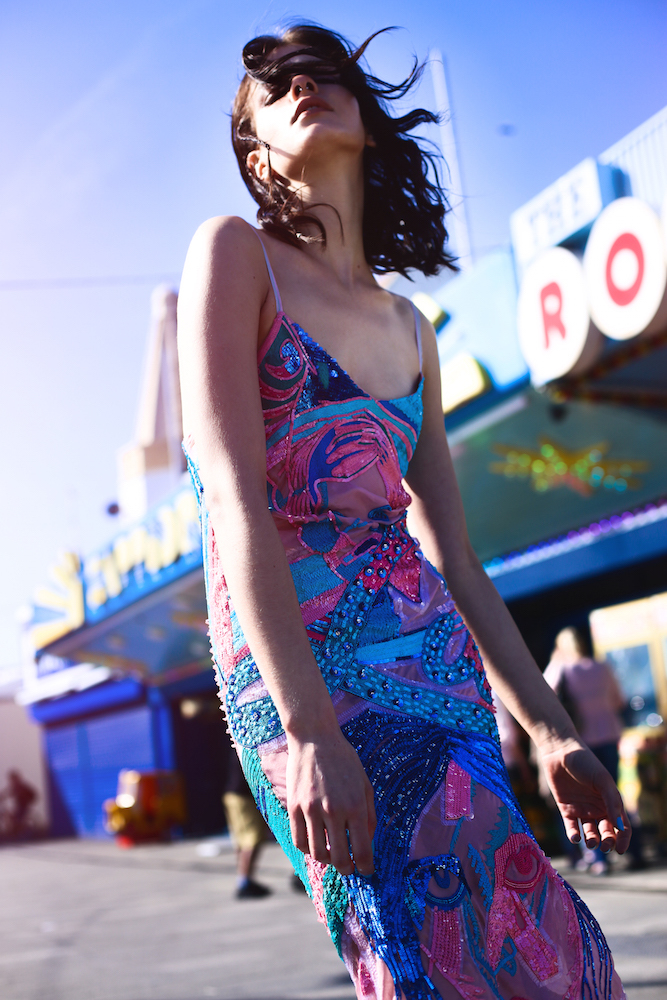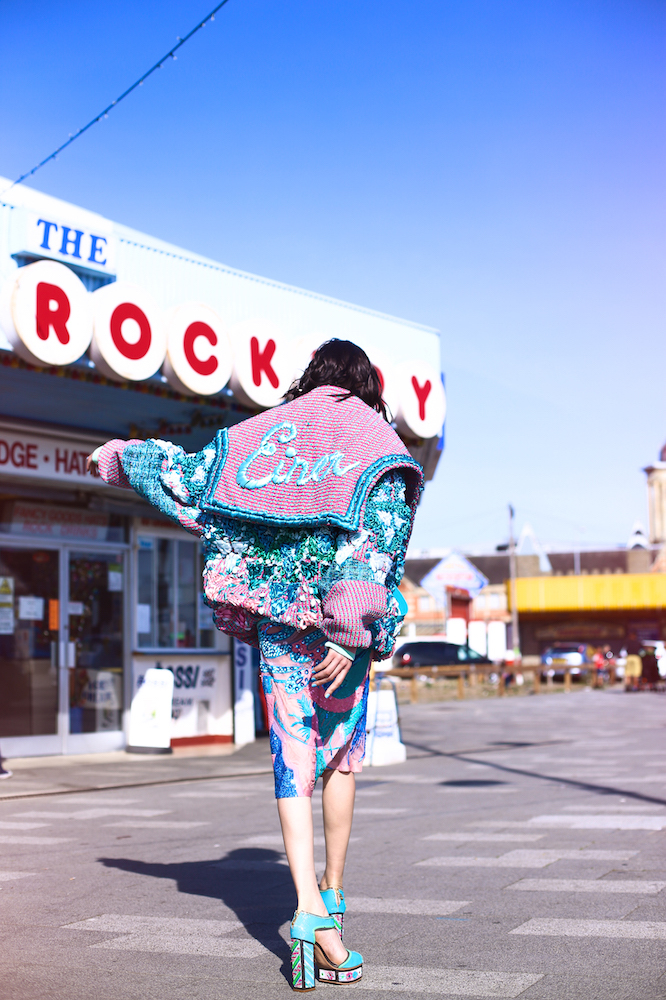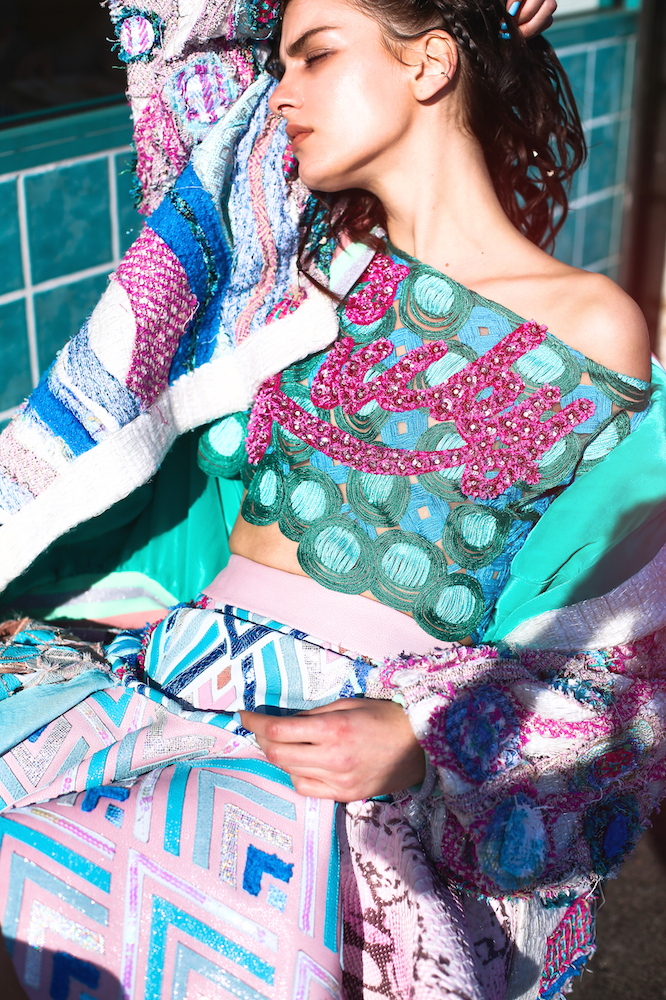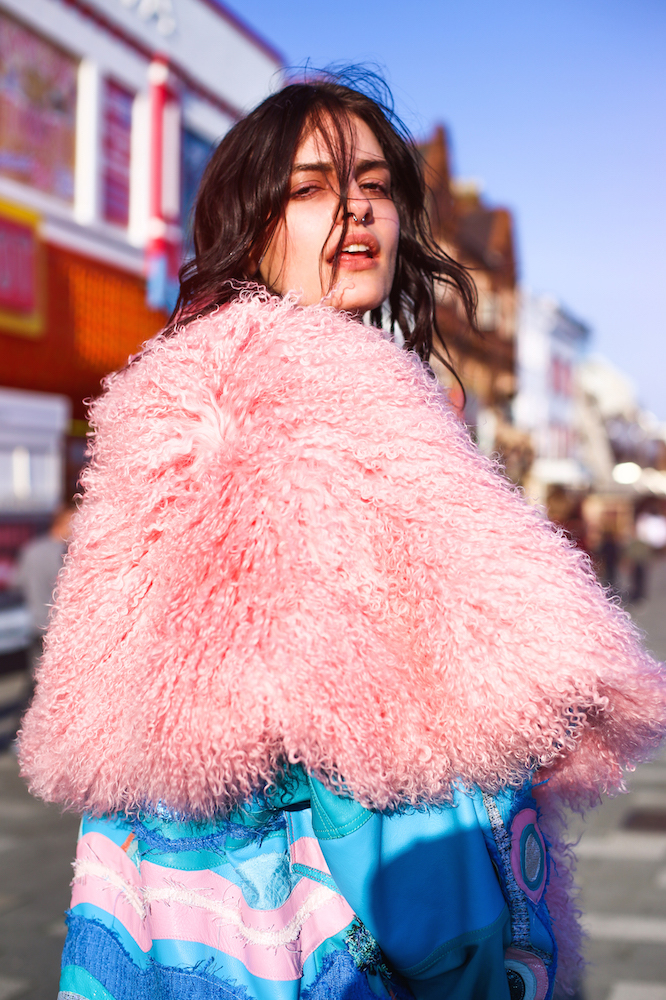Roberta Einer was born in Tallinn, Estonia, but there’s definitely some East London mixed in with her Baltic accent. It’s not surprising given she’s lived in the UK since she was a precociously ambitious tween. “It’s a bit of a cliché, but when I was 13, I decided I was going to become a fashion designer,” she says. “I secretly applied to boarding schools in London, got into some, and then told my parents that I needed to move to England.”

She’s still amazed that her parents listened to her, but her grit paid off. This past June, she graduated from the fashion BA program at the University of Westminster in London, making nearly every “ones to watch” list (including ours). And her resume also includes a degree from Central Saint Martins and work experience at Alexander McQueen, Mary Katrantzou and Balmain – where she honed her signature more-is-more, fuck-it-lets-add-more-sequins aesthetic while working as a design assistant.
Looking at Roberta’s graduate collection, you can’t not smile. It’s a maximalist ode to cheerleaders, beribboned Russian hairpieces, and teen movies, executed in pastel tweeds and turquoise and hot-pink embroidery. There are peppy 50s-style cheer squad jackets. One mini dress has “Calling all girls” beaded onto the back. And you want to nest in the giant baby-pink shearling shrugs. Together, the pieces bring to mind mermaids, a 1994 Claudia Schiffer in a Chanel mini suit and the slightly deranged all-American high school world of Crybaby.
We caught Roberta on the phone before she hopped on the Eurostar to Paris, where she is presenting her graduate collection at the Who’s Next showcase today.
How ready are you feeling to show your spring/summer 16 collection in London later this month?
Spring is really a development of my graduate collection, so I feel pretty ready. It has the same themes and inspirations, I’ve just really improved the fits and quality. It’s also a bit more elegant and grown up. But I’ve been working with these references since February, so I’m even more excited to work on fall/winter.

What are those references?
It started with the “Post Pop: East Meets West” exhibition at the Saatchi Gallery in London, which was about how Soviet Pop Art was influenced by American Pop Art. I saw two paintings there with these cheesy, happy color palettes I loved. Then I started working with graphics from Soviet posters, and also looking at American teen movies. From there, I spread out and looked at all things American and all things Russian, trying to draw parallels between them. For me, Soviet school uniforms look very similar to American cheerleading outfits, and in Russia, they have these giant ribbon hairpieces which look like cheerleading pompoms.
I also saw on your Instagram that you collected some amazing vintage pieces.
Once I’ve done my secondary research for a collection, I always go vintage shopping for garments – whether it’s for a specific silhouette or a type of embroidery. I bring them into the studio and at first, I’m like, “Oh, this jacket is ridiculous” or “That color is so weird,” then by the end of the collection I’m wearing half of the pieces. Before this collection I never had any baseball jackets or cheerleader crop tops!

Where do you source pieces?
Mostly from London, from Brick Lane and Portobello, but also from eBay, mainly for the Soviet stuff like army jackets and school uniforms. I’ve already found some amazing pieces for fall/winter that are waiting for their turn. They’re the complete opposite of what I’m doing for spring, but I think the variety is [important]. You can’t keep making the same things and using the same references.
What are you thinking about for fall?
A friend from my course gave me a book about cowboys and the embroidery they use for their formal wear. It’s all this embroidered leather in amazing colors and patterns. I want to go on a proper research trip to the States. Probably Texas – to smaller places rather than the big cities.

What do you see as the common thread between your collections?
Embroidery is a huge thing. From McQueen to Mary [Katrantzou] to Balmain, that’s where my experience has been. It’s not about the beading or the sequins or the stitch, it’s about all the materials and the textures you can create, with tassels, ropes, cords, macrame. I have an amazing factory (it’s the same factory that does Balmain’s embroidery) and I develop things with them.
How did working at Balmain affect your design process?
It completely changed things. Before that, my aesthetic was very, very minimalist. But Olivier [Rousteing] and the other designers there are about having fun. It made me want to be excited about what I’m doing rather than worrying if something is too much or too little. At Balmain, if you were in doubt, you added more gold; if you weren’t sure if something was shiny enough, you put on more Swarovski crystals. It was about adding, adding, adding and making the most exciting piece possible. That stuck with me.

Now, when you’re designing your own pieces, what rule do you keep in mind?
It’s always about making something that will bring out the best in the girl or woman who wears it.
I loved all the patches and girl power motifs in the collection!
It makes me happy to know that people will read the graphics and look at the drawings and smile. I think there should be more of that positive vibe in fashion. You shouldn’t be depressed when you put something beautiful on.
Credits
Text Alice Newell-Hanson
